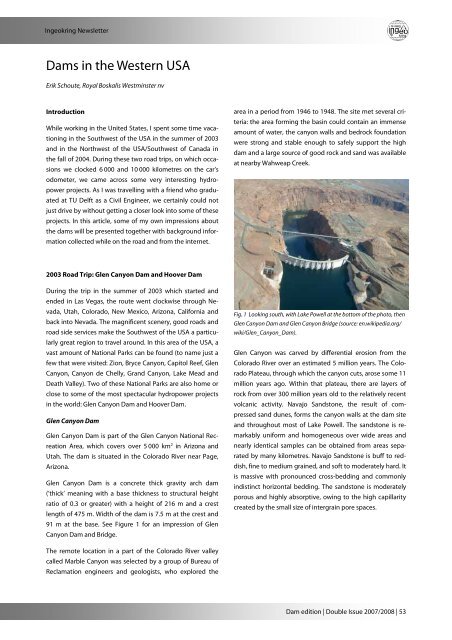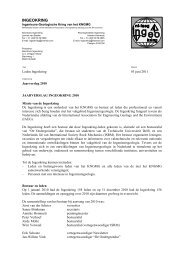News letter Dam edition
News letter Dam edition
News letter Dam edition
- No tags were found...
Create successful ePaper yourself
Turn your PDF publications into a flip-book with our unique Google optimized e-Paper software.
Ingeokring <strong>News</strong><strong>letter</strong><br />
<strong>Dam</strong>s in the Western USA<br />
Erik Schoute, Royal Boskalis Westminster nv<br />
Introduction<br />
While working in the United States, I spent some time vacationing<br />
in the Southwest of the USA in the summer of 2003<br />
and in the Northwest of the USA/Southwest of Canada in<br />
the fall of 2004. During these two road trips, on which occasions<br />
we clocked 6 000 and 10 000 kilometres on the car’s<br />
odometer, we came across some very interesting hydropower<br />
projects. As I was travelling with a friend who graduated<br />
at TU Delft as a Civil Engineer, we certainly could not<br />
just drive by without getting a closer look into some of these<br />
projects. In this article, some of my own impressions about<br />
the dams will be presented together with background information<br />
collected while on the road and from the internet.<br />
area in a period from 1946 to 1948. The site met several criteria:<br />
the area forming the basin could contain an immense<br />
amount of water, the canyon walls and bedrock foundation<br />
were strong and stable enough to safely support the high<br />
dam and a large source of good rock and sand was available<br />
at nearby Wahweap Creek.<br />
2003 Road Trip: Glen Canyon <strong>Dam</strong> and Hoover <strong>Dam</strong><br />
During the trip in the summer of 2003 which started and<br />
ended in Las Vegas, the route went clockwise through Nevada,<br />
Utah, Colorado, New Mexico, Arizona, California and<br />
back into Nevada. The magnificent scenery, good roads and<br />
road side services make the Southwest of the USA a particularly<br />
great region to travel around. In this area of the USA, a<br />
vast amount of National Parks can be found (to name just a<br />
few that were visited: Zion, Bryce Canyon, Capitol Reef, Glen<br />
Canyon, Canyon de Chelly, Grand Canyon, Lake Mead and<br />
Death Valley). Two of these National Parks are also home or<br />
close to some of the most spectacular hydropower projects<br />
in the world: Glen Canyon <strong>Dam</strong> and Hoover <strong>Dam</strong>.<br />
Glen Canyon <strong>Dam</strong><br />
Glen Canyon <strong>Dam</strong> is part of the Glen Canyon National Recreation<br />
Area, which covers over 5 000 km 2 in Arizona and<br />
Utah. The dam is situated in the Colorado River near Page,<br />
Arizona.<br />
Glen Canyon <strong>Dam</strong> is a concrete thick gravity arch dam<br />
(’thick’ meaning with a base thickness to structural height<br />
ratio of 0.3 or greater) with a height of 216 m and a crest<br />
length of 475 m. Width of the dam is 7.5 m at the crest and<br />
91 m at the base. See Figure 1 for an impression of Glen<br />
Canyon <strong>Dam</strong> and Bridge.<br />
Fig. 1 Looking south, with Lake Powell at the bottom of the photo, then<br />
Glen Canyon <strong>Dam</strong> and Glen Canyon Bridge (source: en.wikipedia.org/<br />
wiki/Glen_Canyon_<strong>Dam</strong>).<br />
Glen Canyon was carved by differential erosion from the<br />
Colorado River over an estimated 5 million years. The Colorado<br />
Plateau, through which the canyon cuts, arose some 11<br />
million years ago. Within that plateau, there are layers of<br />
rock from over 300 million years old to the relatively recent<br />
volcanic activity. Navajo Sandstone, the result of compressed<br />
sand dunes, forms the canyon walls at the dam site<br />
and throughout most of Lake Powell. The sandstone is remarkably<br />
uniform and homogeneous over wide areas and<br />
nearly identical samples can be obtained from areas separated<br />
by many kilometres. Navajo Sandstone is buff to reddish,<br />
fine to medium grained, and soft to moderately hard. It<br />
is massive with pronounced cross-bedding and commonly<br />
indistinct horizontal bedding. The sandstone is moderately<br />
porous and highly absorptive, owing to the high capillarity<br />
created by the small size of intergrain pore spaces.<br />
The remote location in a part of the Colorado River valley<br />
called Marble Canyon was selected by a group of Bureau of<br />
Reclamation engineers and geologists, who explored the<br />
<strong>Dam</strong> <strong>edition</strong> | Double Issue 2007/2008 | 53




